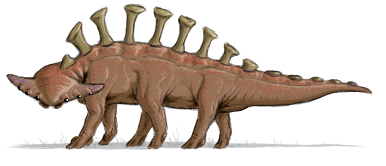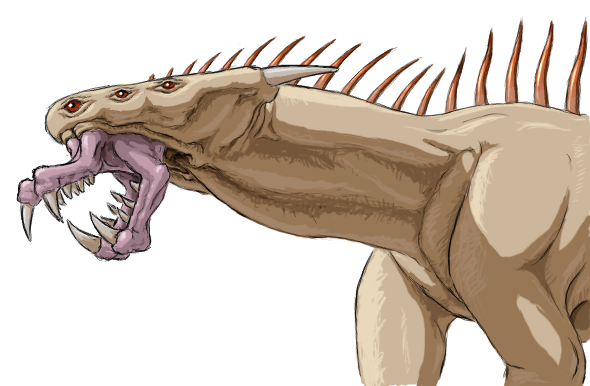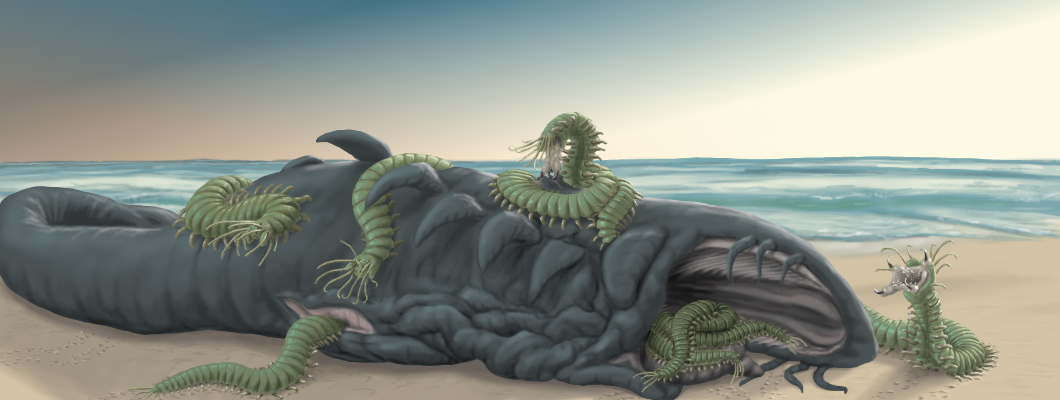| Žemyna Field Guide | |||
|
Anvilbacks are named for the flat-headed spines that grow from their back. They use these to recognize their own kind, and for displays to attract mates or intimidate rivals.
Bush arrowheads subdue their prey by wrapping their bodies around their quarry, holding it tight with their claws while they use their jaws to deliver a lethal bite to their prey's vital spots.
The greater molochs live in small family groups, fiercely defending their territory from other groups of greater molochs. The younger members of the pack use their speed to chase down and harry prey, driving them into ambush where the size and strength of their parents can be used to take down their quarry with less risk. This picture of a yawning greater moloch shows the typical dental arrangement of arrowheads. Their jaws are modified limbs, normally stowed folded under their head. The last "wrist" segment features a single large fang that can be independently oriented, ideal for restraining prey, while the "forearm" section contains many smaller teeth for sawing up flesh and crunching bone.
Leviathans are mouth brooders. The female lays eggs which the male fertilizes and then takes into the brood pouch in his throat until they hatch. The young feed on plankton caught in their father's sieves, occasionally venturing out but returning to the shelter of their father's brood pouch until they are mature enough to survive on their own. If harassed, a leviathan will first attempt to flee. But if sufficiently provoked, it will turn on its attackers, ramming with their snout or smashing with blows from their body. Legworm: Žemyna's legworms are opportunistic hunter-scavengers. Their elongated, segmented bodies are boneless, capable of contorting to squeeze through narrow crevices or stretching to nearly double their resting length. Each segment has a pair of legs equipped with a sharp claw that they use to climb or to dig into their prey like meat hooks. The head ends in a swarm of sensory tentacles, and can evert a set of retractable, four-part jaws with long, sharp piercing fangs. Legworms come in many species, from 10 cm long wiggly things that hide under rocks and damp logs to anaconda-sized serpents. Each of a legworm's segments contains redundant organs - a heart, ganglion, lung-gills, kidneys, and so on. This allows it to sustain significant amounts of injury before dying. Only damage to the brain, in the foremost segment, will instantly incapacitate the creature. A primary nerve cord, a gut, and four great vessels run the length of the creature. Severing the main nerve cord keep the brain from controlling anything below the point where the break occurred, resulting in the lower parts writhing around. Opening one of the great vessels will cause muscular contractions around the injury that pinch it shut, preventing massive blood loss but reducing the legworm's endurance. |
 Anvilback Arrowhead: While not the largest of the arrowheads, the anvilback is perhaps the most dangerous to people. Growing to the size of a Bengal tiger, it adapts well to farmland, disturbed areas, and semi-urban environments. It is an opportunistic predator and scavenger, eating nearly anything that it can overpower.
Anvilback Arrowhead: While not the largest of the arrowheads, the anvilback is perhaps the most dangerous to people. Growing to the size of a Bengal tiger, it adapts well to farmland, disturbed areas, and semi-urban environments. It is an opportunistic predator and scavenger, eating nearly anything that it can overpower.
 Bush Arrowhead: Bush arrowheads are typical of the small-to-medium sized arrowheads of Žemyna – long bodied, short-legged, capable of rapidly scurrying through brush, up trees, across water, or down burrows in pursuit of their prey. Bush arrowheads are often found near people, and have colonized many urban areas where they prey on possums, rats, pigeons, starlings, squirrels, cats, small dogs, and other small animals as well as raiding garbage.
Bush Arrowhead: Bush arrowheads are typical of the small-to-medium sized arrowheads of Žemyna – long bodied, short-legged, capable of rapidly scurrying through brush, up trees, across water, or down burrows in pursuit of their prey. Bush arrowheads are often found near people, and have colonized many urban areas where they prey on possums, rats, pigeons, starlings, squirrels, cats, small dogs, and other small animals as well as raiding garbage.
 Greater Moloch Arrowhead: The greater moloch arrowhead is Žemyna's largest land predator, reaching masses of 3,000 to 4,000 kg as an adult. They are not found close to civilization, requiring large herds of prey animals to sustain their bulk.
Greater Moloch Arrowhead: The greater moloch arrowhead is Žemyna's largest land predator, reaching masses of 3,000 to 4,000 kg as an adult. They are not found close to civilization, requiring large herds of prey animals to sustain their bulk.
 Leviathan: The largest of Žemyna's animals, Leviathans are enormous pelagic filter feeders, cruising the oceans sucking in vast quantities of plankton to feed their enormous bulk. Their long bodies may recall the sea serpents of old Earth lore, but these beasts are harmless to people unless provoked.
Leviathan: The largest of Žemyna's animals, Leviathans are enormous pelagic filter feeders, cruising the oceans sucking in vast quantities of plankton to feed their enormous bulk. Their long bodies may recall the sea serpents of old Earth lore, but these beasts are harmless to people unless provoked.